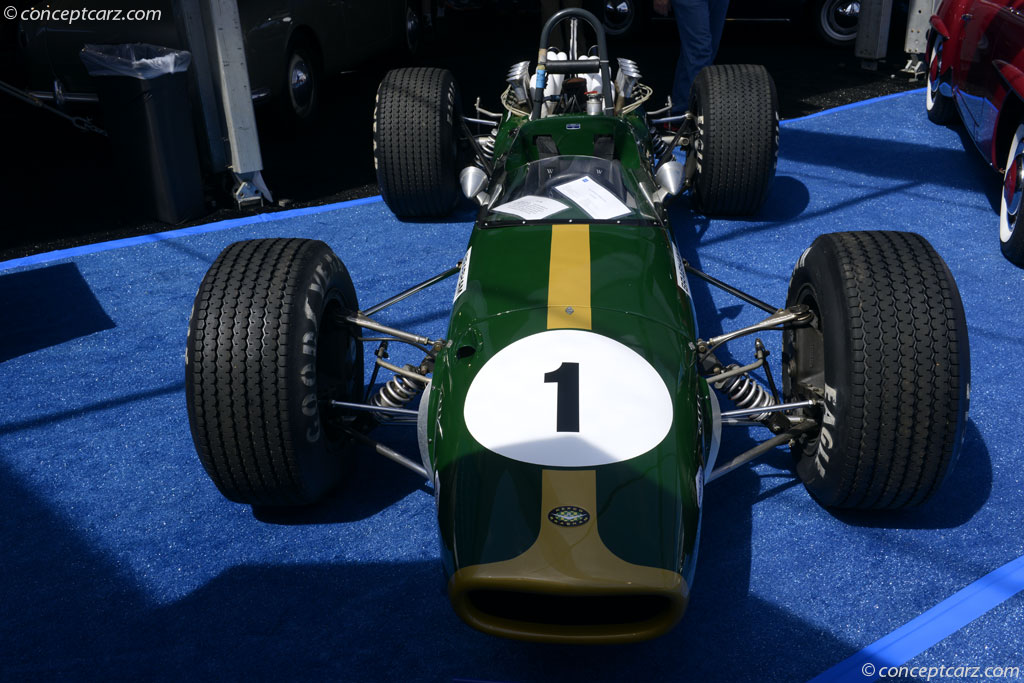1967 Brabham BT24 Navigation



Monoposto
Chassis #: BT24-1
Having won back-to-back Formula 1 World Championships for Cooper Cars in 1959 and 1960, and while still under contract to Cooper, Sir Jack Brabham began a quiet partnership with Ron Tauranac in 1961. That partnership would produce winning cars clear through the BT33 F1 model of 1970. A brilliant engineer and fellow Australian, Tauranac's designs began with the MRD-1 Formula Junior (for Motor Racing Developments), which was driven by yet another Aussie, Gavin Youl. He had very good success in the 1961 British Formula Jr. Championship.By the end of 1961, with the Brabham-Tauranac partnership was out in the open, Sir Jack left Cooper and both MRD (their design/build firm) and the Brabham Racing Organization (their Grand Prix team with Sir Jack racing the cars of his own name) were off and running. While development began on the BT3 Formula 1 car, MRD developed the BT2 customer Formula Junior cars, a refinement of the MRD-1 F-JR. MRD eventually became the official chassis supplier for the competition team Brabham Racing Organization. Tauranac designed the cars while Dan Gurney and Brabham undertook driving duties. The team did rather well during its early years, finishing as high as 3rd in Constructors' Championship points in 1965. For 1966 and 1967, the team would experience back-to-back Drivers' and Constructors' Championships after changes to Formula 1 rules were made. For 1966, new three-liter displacement rules had manufacturers searching for a suitable powerplant. Most teams selected Coventry's time-tested Climax inline four-cylinder unit. Other teams instead chose to develop new motors from the ground up, which predictably led to teething and reliability issues.
Brabham sought help from the Repco manufacturing company of Australia, which had supplied him with parts over the years. Engineer Phil Irving took an Oldsmobile F85 V-8 and replaced the traditional overhead valve arrangement with a single camshaft, minimizing the engine's physical profile. The block was eventually recast in a lightweight aluminum alloy. The result was a very reliable, if only modestly powerful, engine that was more than capable of carrying the lightweight BT19 and BT20 chassis to the 1966 Formula 1 title. Brabham, himself, won his third Drivers' Championship, becoming the first man in Formula 1 history to win a title in a car of his own manufacture.
Jack Brabham drove chassis number BT24-1 a final time in the 1968 season debut at Kyalami, South Africa, where the car retired early. By this point in racing history, Brabham Racing was forging ahead with its new BT26 chassis, and the BT24s were retired from team use. After the Kyalami date, the car was sold to a South African enthusiast who continued to campaign it in the local national series. The Brabham BT24-1 was retained in South African, mainly under the care of one collector during the 1970s, before being returned to England in 1980 and displayed in the Donington Grand Prix Museum for almost two decades.
By Daniel Vaughan | Nov 2014
- 1967 Brabham BT24 Menu
- Article
- Image gallery
- Valuation
- Specifications
Brabham
Similar Automakers
Related Drivers
 Kurt Karl-Heinrich Ahrens, Jr.
Kurt Karl-Heinrich Ahrens, Jr. Sir John Arthur 'Jack' Brabham
Sir John Arthur 'Jack' Brabham Silvio Moser
Silvio Moser Karl Jochen Rindt
Karl Jochen Rindt Sam Tingle
Sam TingleRelated Teams
 Brabham Racing Organisation
Brabham Racing Organisation  Caltex Racing Team
Caltex Racing Team  Silvio Moser Racing Team
Silvio Moser Racing Team  Team Gunston
Team Gunston | Related F1 Articles | |
|---|---|
| Jack Brabham: 1956 Formula One Season | |
1967 Brabham BT24 Vehicle Profiles
Recent Vehicle Additions
Related Automotive News

Brabham Automotive Debuts In North America With Dan Gurney Tribute BT62 At Monterey Car Week
Debut of Brabham BT62 in North America at Monterey Car Week
Stunning new track-only supercar appearing throughout the week with partner Michelin
BT62 presented in tribute livery, marking Dan Gurneys 1964 F1 Grand Prix win for Brabham
Heralding t...

WORLD-FIRST DISPLAY OF ALL SEVEN REMAINING LOTUS 49S LINING-UP AT AUTOSPORT INTERNATIONAL
Autosport International to host display featuring all seven remaining Lotus type 49 cars thanks to their owners from around the world
Celebrations at Autosport International to mark 50 years since this pioneering F1 car first raced
To this day, th...
R.H.H. Parnell: 1959 Formula One Season
In 1951, Reg Parnell pulled off a huge upset surviving an absolute deluge of rain that flooded the Silverstone circuit during the BRDC International Trophy race. Parnell would manage to keep his Ferrari 375 under control long enough to be declared the...

High Efficiency Motors: 1958 Formula One Season
C.T. Tommy Atkins would start out his career as a motorcycle racer riding Douglas motorcycles in the early 1930s. By the time the mid-to-late 50s rolled around, Atkins had moved on from racing, but not very far. Perhaps feeling a need to support up-and-coming...

An Era of Perspective
Everyone loves a champion. At least that is the saying. But it isnt necessarily true. Instead, everyone loves their champion. When another proves to be equal or stronger, then all reason slips through the window when judging skill.
The lamentations...






















